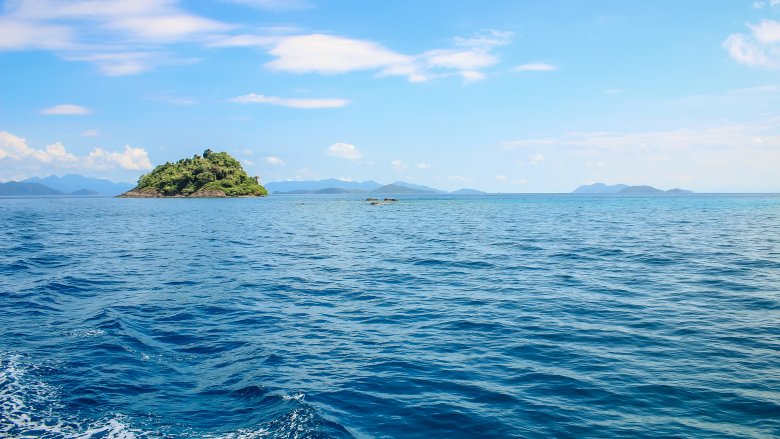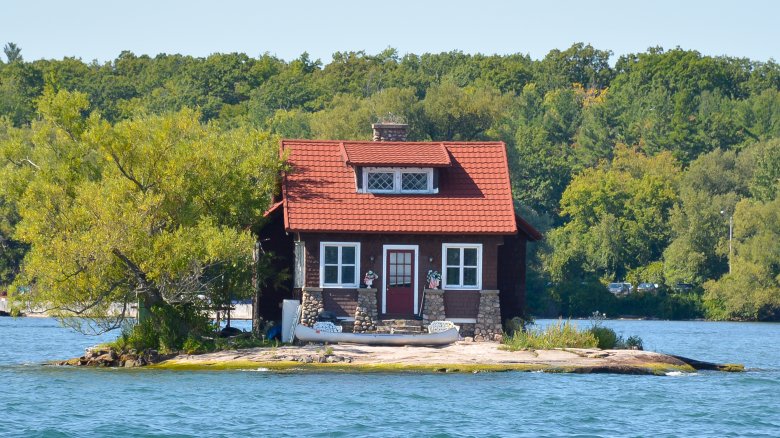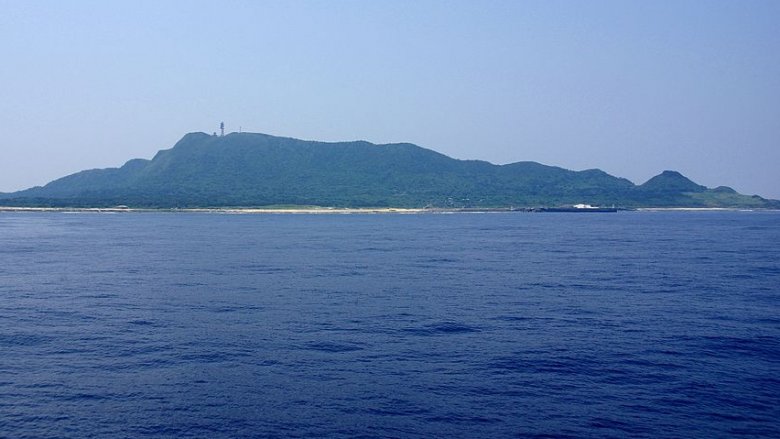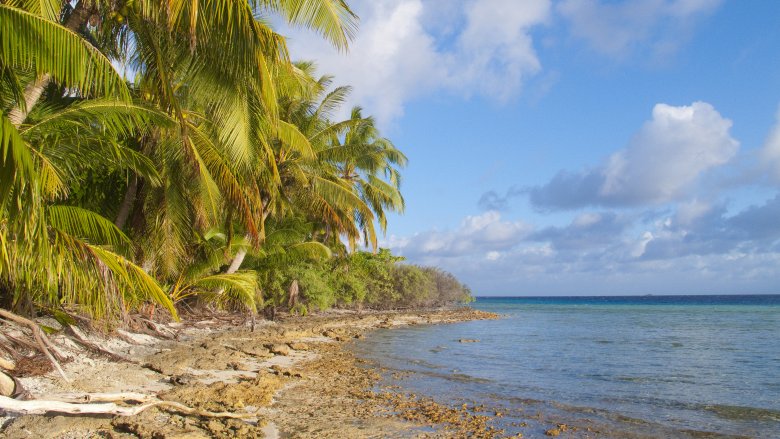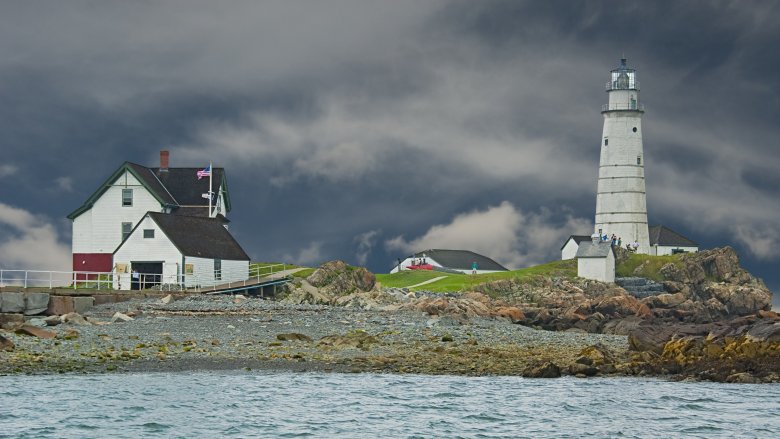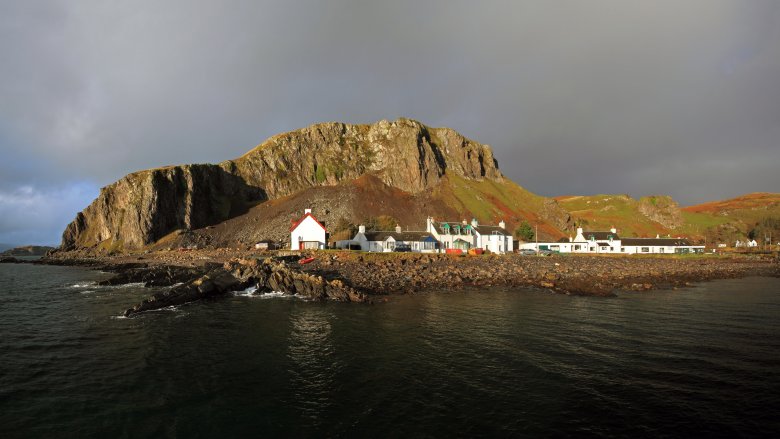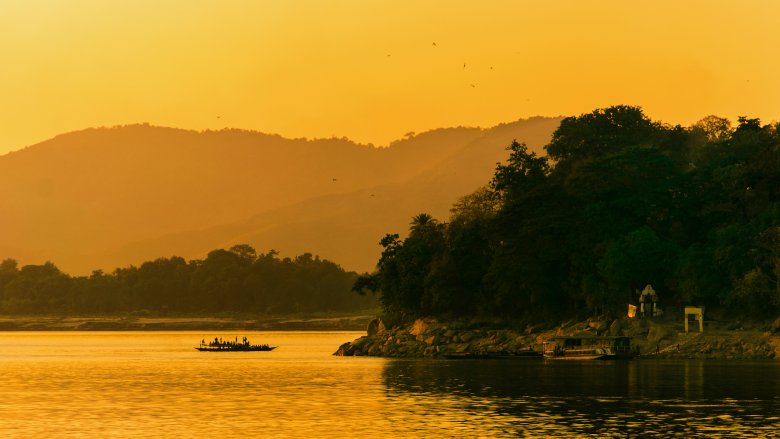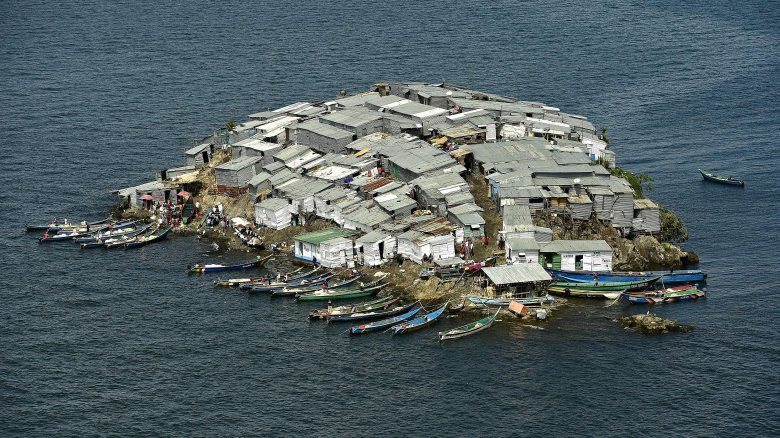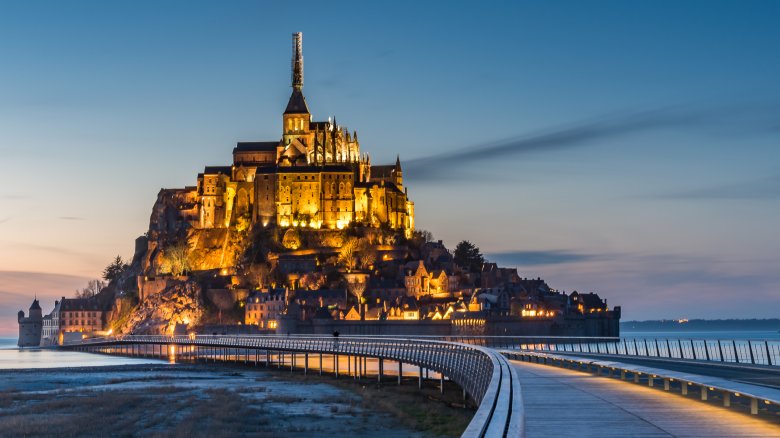The Smallest Islands That People Actually Live On
Just about everyone dreams of living on an island paradise. Some days, you might even be tempted to trade your bills, your boring job, and most of your friends for life as a castaway (minus the sentient volleyball, because no one dreams about that). It's okay, we get it. Seclusion, self-sufficiency, a simpler life — there's no denying the allure of such a lifestyle, though you'd probably have to really like coconuts and fish. And afterward, your memoir will be a guaranteed best seller, so returning to civilization has its perks, too.
Sadly, not all occupied islands qualify as "paradise"; in fact, most of them don't. Unless you're a bazillionaire and can afford to buy a tiny island outright, any place worth living is eventually going to attract other people who want to live there, and before you know it your small island paradise is covered with aluminum shacks, whale bone museums, and people who have something against cars. So just in case you do still think tiny island living is for you, you might want to reevaluate that idea after you get to the end of this story.
Not Quite Room Enough Island
At first glance, this island residence looks super cool. It's a tiny cottage on a tiny island with one tree and a beach just big enough for a few plastic chairs and a picnic table. According to Conde Nast Traveler, the island is 3,300 square feet and is accurately if not particularly creatively named "Just Room Enough Island." Ever since the lighthouse on England's Bishop Rock became automated in 1982, Just Room Enough has claimed the title of "world's smallest inhabited island."
If you think about it long enough, though, the idea of a house on a tennis court-sized island with barely enough yard space for some plastic lawn furniture from Target is terrifying because the water level in a lake tends to rise and fall. Predictably, Just Room Enough's owners have had to cope with flooding — in 2017 the iconic cabin was photographed with sandbags piled on its doorstep to keep down the rising waters during an unusually wet year. So while it would be kind of cool to own the world's smallest inhabited island, the flood insurance might make it sort of cost-prohibitive. Perhaps a name change is in order — how about "Not Quite Room Enough Island?"
Way Too Far Away Island
It takes 12 hours to get to the island of Kotakarajima from the port of Kagoshima in Japan, and only 30 minutes to circumvent the entire island on foot. It's unclear what great universal mysteries might unfold during that walk, but they'd have to be pretty dang profound to make that journey worthwhile.
According to a guidebook for the area, Kotakarajima is the smallest inhabited island in the Tokara Archipelago both by land mass and by population. It's roughly 1/3 of a square mile, but at high tide it loses between 25 and 33 percent of its surface area, which means the island's 37 residents have to pay close attention to the tide schedules or else just forget about their sand castles.
Fortunately there's an inn on the island, a place to swim and a free public bath/hot spring, which should provide tourists with an hour or two of entertainment. Locals depend on outside dollars for survival, so tip generously. Remember the island is tiny and also in the middle of nowhere, so if you upset your hosts you will literally have nowhere to hide, and a few days to wait before the next ferry shows up.
Castaway on purpose
The remote Pacific atoll called Suwarrow has a 50-mile circumference, but only 0.15 square miles of that is actually dry land. Despite its diminutive size, Suwarrow has a pretty rich history. According to Atlas Obscura, in the mid-1800s, two sets of travelers found treasure there. The first found a box of coins worth $15,000 NZ, and the second found a turtle's nest full of pieces of eight, yes, the very same coins the pirate lords were supposed to use to bind the goddess Calypso but didn't because they were all broke.
During World War II, the island was used as a base for "coastwatchers" but had to be evacuated during a hurricane. The coastwatchers left behind their shelters, some water tanks, and a few pigs and chickens, which was handy for the next guy who came along: Tom Neale, who deliberately cast himself away on Suwarrow in 1952 with two cats and some provisions. Neale lived there off and on for 16 years, with his longest consecutive stay between 1967 and 1977. Evidently the experience was mostly meant as material for his memoir, which was called An Island To Oneself and became an international best seller. His book inspired other "castaways" to visit the island, and a few of them set up their own brief residencies.
Today, Suwarrow is one of New Zealand's national parks. It is inhabited by caretakers who live in Neale's abandoned huts for six months of the year.
America's last manned lighthouse
Lighthouse keepers are a dying breed. Today, most functioning lighthouses are automated, so there's no need for someone to be on-site to make sure the light stays on. In fact there is only one lighthouse left in America that still has a keeper — the famous "Boston Light," located on Little Brewster Island, which is roughly 1/10 of a square mile. The original Boston Light was built in 1716 out of "rubblestone" and was powered by candlelight; today's lighthouse is a little more fortified and fully electric. The lighthouse keeper is probably a little redundant since the light is always on, but in 1989 lawmakers decided there should be at least one manned lighthouse left in the United States, probably mostly for nostalgic reasons.
According to the Boston Globe, the Boston Light's current keeper is Sally Snowman, who is the 70th person to hold the job and the first and only woman. Snowman lives alone on site, wears period clothing, and foregoes internet, cable TV, and Starbucks, which basically means her job is totally safe since no one born after 1969 would ever dream of working in such primitive conditions. Snowman is married but her husband doesn't always join her on the island, perhaps because of the whole Starbucks thing.
Do you dislike cars, streetlights and dining options?
Just off the western coast of Scotland is the tiny island of Easdale, where 60 people live on less than half a square mile. According to Undiscovered Scotland, cars are prohibited, there are no streetlights, and if you want to go out to dinner there's exactly one restaurant that you have to walk to in the dark, and it's probably raining. On the plus side, you don't have to walk very far and you will entirely avoid the whole "what do you feel like eating?" conversation that you always have to have whenever you decide to eat out.
Employment opportunities on Easdale consist of working at the restaurant or working at the museum, which leaves exactly 58 Easdalians unemployed. Ah, sorry, that's not exactly true — many of the residents work off-island since it's just a short ferry ride to the mainland, and some of them are involved in the tourism industry, but it's not like most residents have a whole lot of career choices if they decide to pursue employment on the island.
For the most part, you'll find a lot of happy people on Easdale, which is unsurprising since it takes a certain sort of person to pursue a carless, streetlightless, Starbucksless lifestyle in a place that's only accessible by boat. In other words, Easdale is a place you'd only want to move to if you were already pretty sure you'd love it.
Amenities include a small temple and some monkeys
In Hindu mythology, Lord Shiva is the four-armed god of destruction, and once upon a time he brought his wife Uma to live on a tiny little island on the Brahmaputra river in India. Uma loved her home, and that's how the island came to be called Umananda, which is literally translated as "Uma's joy."
According to The Better India, Umananda prides itself on being the smallest inhabited river island in the world, but there are really only five people who live there all the time — three priests and two fishermen — everyone else takes the ferry home every day. The island is also home to the endangered golden langur, which is a small primate with bright yellow fur and a black face.
The island is best known as a destination for pilgrims, who come to visit the Shiva temple, which has stood on the island since 1694 (not counting the year or two after it was destroyed by an earthquake in 1897 and before it was rebuilt by a local merchant). You can't get a Starbucks here, either, but you can get a cup of tea, so that's something. And Umananda looks out at the city of Guwahati on both the north and south ends, so civilization is not far away — if you're into that sort of thing.
A climate change coal mine canary
Once upon a time, the USA said, "Hey people, we're going to blow up the island you live on. Cool? Don't worry, we'll give you a much worse island to live on."
So they did, and the islanders moved to a crappy place called Kili Island and waited for their original island to get cleaned up, but of course it never did because nuclear waste.
Then the USA (and the rest of the world) said, "Hey people, we're going to use too many fossil fuels so the oceans will rise and flood the secondhand island you live on now. Cool? But don't worry because you're islanders, which means you're good at swimming." And the islanders were all, "Heck no, please give us a new island," and the USA mostly just whistled and looked around and pretended like no one said anything.
Yep, the inhabitants of Kili Island, which is just 0.36 square miles, live there because the United States government used their original home as a nuclear test site. According to Radio NZ, between 1946 and 1954, 24 weapons were tested on Bikini island, including a hydrogen bomb. And now king tides have make Kili, which has been called "the canary in the climate change coal mine," inhospitable. Roughly one-third of Kili Island's homes have already been abandoned as uninhabitable, and there's no longer a runway because the runway is a river. And there's still no new home in the works for the islanders.
And you thought your neighbors were too close
Some islands are paradise, some are crappy, and some are just okay, but one island in particular is a living hell. According to The Telegraph, Migingo Island is less than an acre of moss and rock in Africa's Lake Victoria, and it's currently home to around 500 people. The island's sordid history can be traced back to 2002, when almost no one noticed or cared about it. Then, a single fisherman decided to build a house there after discovering that fishing near the island was astonishingly good — one boat can still catch more than 200 pounds of Nile perch in a single day.
The fisherman's secret fishing spot didn't stay secret for long, and pretty soon he was joined by other fishermen, and then Migingo was transformed from a slab of moss and rock that nobody cared about to an overcrowded mini-city of tin shacks, pubs, and brothels.
Because living on less than an acre of land with 500 people is not sucky enough all by itself, word of Migingo's fishing bonanza eventually reached the Kenyan and Ugandan governments, who both wanted a piece of that action, and actual war broke out — although only about a dozen soldiers can actually advance on the island at any given time because of its diminutive size. So not only is Migingo a very small island with a very large population, but it's also one of the world's tiniest war zones. Kili Island is starting to look pretty good.
Migingo but without the tiny war
If Migingo is a little too crowded and too occupied-by-a-hostile-foreign-power for your tastes, there's always Santa Cruz del Islote, which is around two and a half times the size of Migingo with a mere 45 families living in 97 homes. Sounds pretty spacious until you consider that that's still about four times the population density of Manhattan. According to National Geographic, fishermen once used the island to shelter during storms and to sort of hang out and regroup after a long day at sea. The island's coral reef provides good fishing, which is why people eventually started coming there not just to relax but to build homes and raise families.
This actually sounds okay until you consider a couple of small problems. First, there is no drinking water on the island — residents have to use rain barrels to capture water during storms. Fortunately the island is not so remote that a drought would mean certain death — it takes just two hours to reach the mainland. But pretty much everything that can't be found in the ocean has to be shipped in by boat, and kids have to endure four hours of commute time a day or leave the island altogether if they want to be educated past the 10th grade. It's a hard life, but islanders seem to think it's worth it. And there are no soldiers or king tides to complicate things, so it beats at least one or two "island paradises" on our list.
Just you, me and 2.5 million tourists
Which would you prefer, life on a tiny island with a few hundred other residents, or life on a marginally larger island with 2.5 million tourists coming and going every single year? Just to put that into perspective, that's roughly 6,850 non-resident "guests" every day, which you could think of as business opportunities or as traffic blocking, restaurant clogging, trash-creating stains on your island paradise.
Around 50 people live on Mont Saint-Michel, which is has a total area of about 0.375 square miles. That actually sounds quite roomy until you start thinking about where you're going to put the other 6,850 people. So what's the appeal? According to Rick Steves, it's the 15th-century abbey that sits on the island's peak, one of the top Christian pilgrimage sites in the world.
Fortunately for that little handful of actual residents, the general consensus seems to be that tourists equal dollars. That doesn't mean residents don't find them annoying, it just means they're likely to keep their opinions to themselves. The streets of Mont Saint-Michel are packed with souvenir and fast food stalls, which are evidently part of a long and glorious tradition of selling cheap crap to tourists that dates all the way back to the Middle Ages. But hey, if you're going to have to watch your beloved island paradise get trampled under the feet of 2.5 million tourists annually, there might as well be something in it for you, too.
Just you, me, and some guy named Miguel
Adrift in the Sea of Cortez is a little island called Isla Coyote, which is roughly 1/10 of a mile from end to end. According to Roads Less Traveled, its only current occupant appears to be some guy named Manuel, who has lived there for 50 years and is currently sticking around in a sort of caretaker role while his family is temporarily on the mainland. Isla Coyote was originally settled in the 1940s by a shark fisherman, whose primary motivation appears to have been escape from a bunch of tiny, biting insects. Which really is as good a reason as any for settling down on an island in the Sea of Cortez.
There were once 30 families living on Isla Coyote, though Roads Less Traveled does not appear to know where they all went. If you decide to visit Isla Coyote, Manuel is evidently a pretty hospitable guy. He'll give you the grand tour of the island and its most popular attraction, the "whale museum," which appears from photographs to just be a pile of sun-bleached bones with labels on them. Granted the whole tour probably only takes a few minutes, so it's not like Miguel's going to feel all that put out by your arrival.
